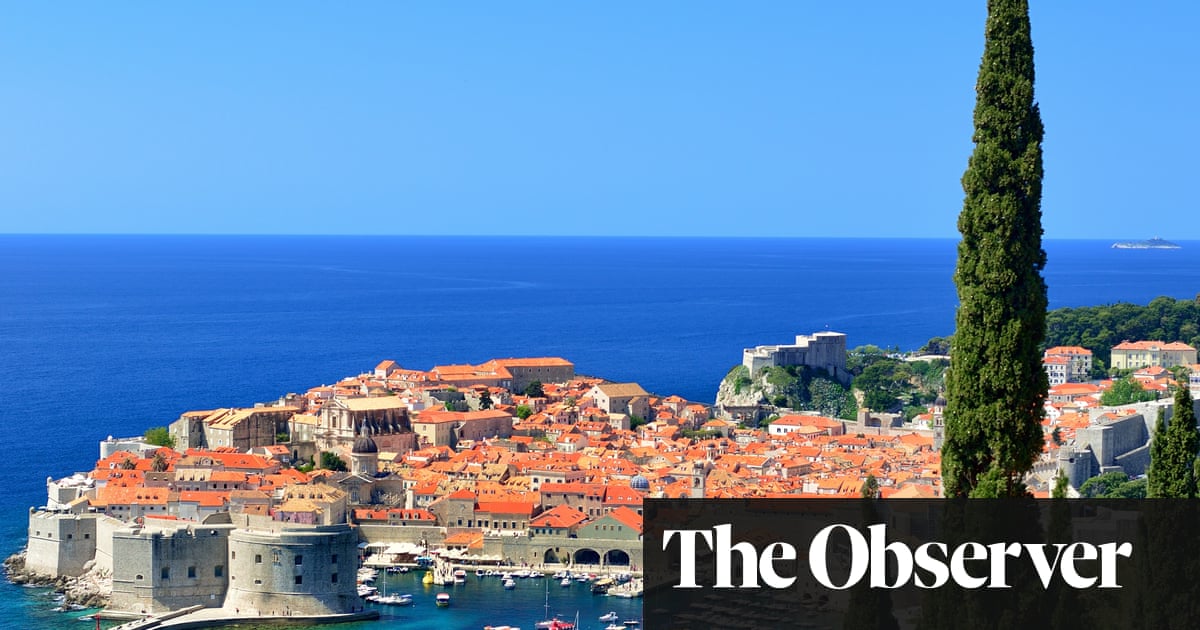It is early morning in the Old Town, when the tangle of pretty cobbled alleyways and ancient stone stairways are relatively empty and you can wander around the creamy, marbled Stradun (Placa) – Main Street – free from the crowds.
It would be tempting to stop at one of the cafés or browse the markets in Gundulic Square – its stalls piled high with strawberries, oranges, fresh figs and cherries – but our guide, Ante Daničić, has other ideas and is keen to get on. To truly appreciate Dubrovnik, you have to learn about its history first. “You need to understand that it’s always been a melting pot here,” says Daničić. “You can see it in the food,” he says: “Turkish baklava, Greek moussaka, Italian pasta. Bari in Puglia is only four hours across the Adriatic by speed boat.”
At the crossroads of west and east, a crucial connection point between Rome and Constantinople (then capital of the Roman empire, now Istanbul), Dubrovnik has always been caught in the middle, neither one nor the other, desired and vulnerable. In the 13th century, the city walls were doubled in size and the cliffs fortified for natural protection, but still they were attacked. “The Romans arrived first. Then came the Venetians in the 13th, the Ottomans in the 16th and 17th, and the French in the 19th, followed by the Austrians.”
Daničić is passionate about his city, even more so when he recalls the Croatian war of independence in the early 1990s – he still remembers vividly what it was like as a young child in Dubrovnik during the war, how he moved to the hotel we’re staying at with his family to escape the worst of the shelling. Which is why, he says, no stay here is complete without visiting Sponza Palace in Luža Square, home to the state archives and also a memorial room with extensive photography of those who died and pictures of Dubrovnik under siege.
By the time we leave, the main square is filling up with tourists and it’s a relief to climb back into Daničić’s electric tuktuk just outside the city walls. The combination of some scenes from Game of Thrones being filmed here, social media and two ships a day depositing 5,000 visitors, means that this small town of 42,000 can easily feel overwhelmed. But it’s not always like this, says Daničić. “Everyone here works in tourism. Our season opens in April and closes in November and during that time we take no holidays, keep on working as hard as we can to store up money for the winter when nothing much happens.” Which probably makes winter the ideal time to visit.
We leave the crowds behind as Daničić speeds away from the Old Town, up towards Srdj Mountain, just behind the city. At the top is one of Dubrovnik’s most picturesque spots: the Panorama Restaurant & Bar. Close to the mountain edge, the pretty terrace offers vertiginous views of the sea and the Old Town, its terracotta roof tiles and gleaming white buildings snugly encased by grey city walls; from up here it looks like an oyster protecting its pearl.
It’s one of the great sights to be enjoyed with chilled rosé and plate after plate of fresh seafood: prawns, octopus, sea bass and mussels. Next to the restaurant is the cable car, the quickest and most scenic way back down to town, with more stunning views of the Adriatic riviera as you slowly descend. From the Old Town it’s a short bus ride to the sheltered bay at Babin Kuk on the Lapad peninsula where we’re staying at the Valamar Tirena Hotel. An ideal place for families, it has a large swimming pool surrounded by landscaped gardens with pretty Hawaiian-style parasols to lounge under.
There are plentiful buffet breakfasts and a recently designed children’s club, Maro World, that would give the Science Museum’s play area a run for its money. This place takes children’s activities to another level, with room after room of immersive experiences – for example, create your own underwater world, play a lifesize version of Minecraft, design your own geometric art or play giant Lego. And it’s under the watchful eye of attentive staff, all of which makes nipping off to enjoy a spa treatment at Valamar Lacroma, the Tirena’s sister hotel next door, more guilt free. There’s also trampolining, adventure playgrounds and an indoor cinema.
after newsletter promotion
As well as the Old Town nearby, there’s Copacabana beach, a stretch of crystal water and fine white pebbles, a stroll away, with its cafés and bars. For a real escape, you can go for a day of island hopping to the Elafiti islands, just north-west of Dubrovnik. Lush and green with lovely beaches, there are six in all, but three main ones to visit – Kolocep, Lopud and Sipan; the first two are car-free and they’re easy to reach by a public ferry that stops off at each one. Or you can rent a private boat for a few hours and enjoy diving, swimming and exploring the reefs and caves.
Whether travelling by ferry or by private boat, try to make sure you come back late in the afternoon, whisking back through the Adriatic waves to Dubrovnik harbour as the sun sets – it is, by far, the best view of all.
Rates at the Valamar Tirena start from £194 B&B a night (valamar.com). A three-hour trip around Dubrovnik with Eco Tuk Tours is £50pp. For more details, go to ecotuktoursdu.hr
